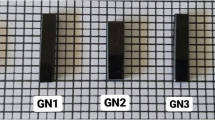Abstract
Near-infrared (NIR) absorption bands related to total water (4000 and 7050 cm−1), OH groups (4500 cm−1) and molecular H2O (5200 cm−1) were studied in two polymerised glasses, a synthetic albitic composition and a natural obsidian. The water contents of the glasses were determined using Karl Fischer titration. Molar absorption coefficients were calculated for each of the bands using albitic glasses containing between 0.54 and 9.16 wt.% H2O and rhyolitic glasses containing between 0.97 and 9.20 wt.% H2O. Different combinations of baseline type and intensity measure (peak height/area) for the combination bands at 4500 and 5200 cm−1 were used to investigate the effect of evaluation procedure on calculated hydrous species concentrations. Total water contents calculated using each of the baseline/molar absorption coefficient combinations agree to within 5.8% relative for rhyolitic and 6.5% relative for albitic glasses (maximum absolute differences of 0.08 and 0.15 wt.% H2O, respectively). In glasses with water contents >1 wt.%, calculated hydrous species concentrations vary by up to 17% relative for OH and 11% relative for H2O (maximum absolute differences of 0.33 and 0.43 wt.% H2O, respectively). This variation in calculated species concentrations is typically greater in rhyolitic glasses than albitic. In situ, micro-FTIR analysis at 300 and 100 K was used to investigate the effect of varying temperature on the NIR spectra of the glasses. The linear and integral molar absorption coefficients for each of the bands were recalculated from the 100 K spectra, and were found to vary systematically from the 300 K values. Linear molar absorption coefficients for the 4000 and 7050 cm−1 bands decrease by 16–20% and integral molar absorption coefficients by up to 30%. Depending on glass composition and baseline type, the integral molar absorption coefficients for the absorption bands related to OH groups and molecular H2O change by up to −5.8 and +7.4%, respectively, while linear molar absorption coefficients show less variation, with a maximum change of ∼4%. Using the new molar absorption coefficients for the combination bands to calculate species concentrations at 100 K, the maximum change in species concentration is 0.08 wt.% H2O, compared with 0.39 wt.% which would be calculated if constant values were assumed for the combination band molar absorption coefficients. Almost all the changes in the spectra can therefore be interpreted in terms of changing molar absorption coefficient, rather than interconversion between hydrous species.
Similar content being viewed by others
Author information
Authors and Affiliations
Additional information
Received: 17 December 1998 / Revised, accepted 8 July 1999
Rights and permissions
About this article
Cite this article
Withers, A., Behrens, H. Temperature-induced changes in the NIR spectra of hydrous albitic and rhyolitic glasses between 300 and 100 K. Phys Chem Min 27, 119–132 (1999). https://doi.org/10.1007/s002690050248
Issue Date:
DOI: https://doi.org/10.1007/s002690050248




